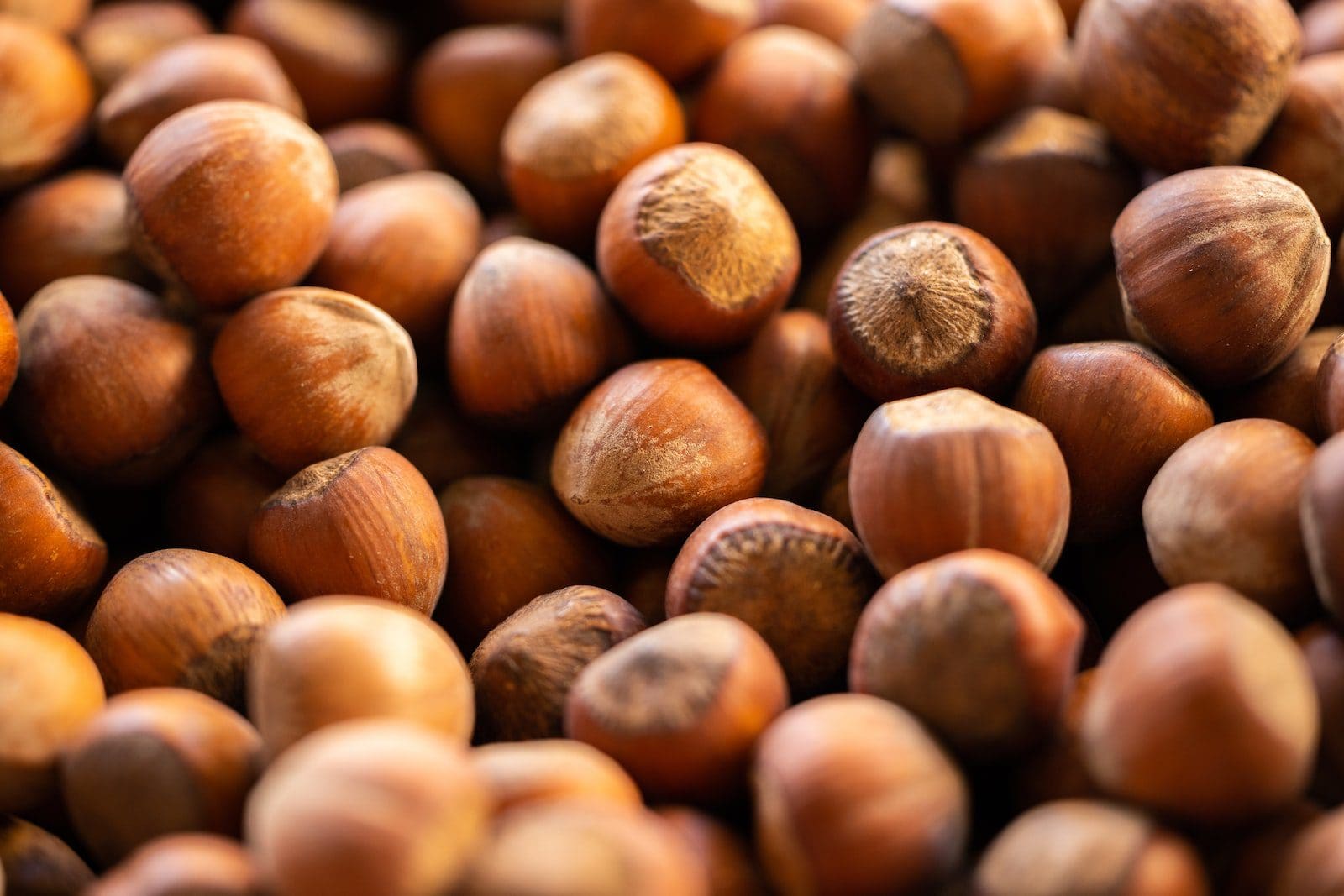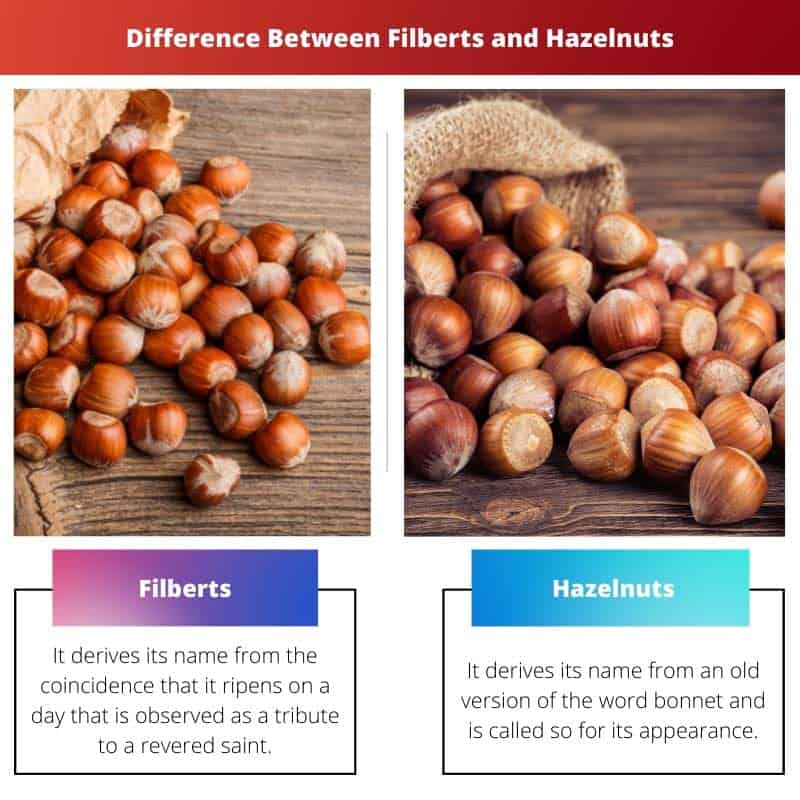Our elders advise us to eat healthily and maintain a balanced diet. Various studies have indicated that it is imperative to consume nuts on a regular basis.
Apart from keeping one in good health, nuts are the key to good hair and skin. A few nuts that are sought-after are macadamia nuts, almonds, hazelnuts, filberts, etc.
Key Takeaways
- Filberts originate from European hazel trees, while hazelnuts come from European and American hazel tree species.
- Hazelnuts are round, while filberts feature an elongated form with a slightly pointed end.
- Both nuts are nutritionally similar, providing high amounts of vitamins, minerals, and healthy fats, but they may taste slightly different due to variations in their respective tree species.
Filberts vs Hazelnuts
The difference between filberts and hazelnuts is that while hazelnuts are plucked off the hazel tree and go by this name in America, filberts are also hazelnuts that go by this name in other parts of the world. The two also differ in their appearance to an extent, and since they belong to the same species, they are thought to be the same.

On the other hand, Filberts are also hazelnuts but are called filberts in other parts of the world other than North America.
It is called so in Europe as it is plucked on a day that is dedicated to a revered saint. It is also said that it might have gotten its name due to its appearance, which resembles facial hair.
Hazelnuts are plucked off the hazel tree and are called so in North America. Hazelnuts are relished by people of all ages.
Its sweetness makes it a desired nut, as very few nuts are sweet and tasty. It is also a key ingredient in one of the most favoured spreads.
Comparison Table
| Parameters of Comparison | Filberts | Hazelnuts |
|---|---|---|
| Land of Origin | Asia | Asia |
| Derivation of Name | It derives its name from the coincidence that it ripens on a day that is observed as a tribute to a revered saint. | It derives its name from an old version of the word bonnet and is called so for its appearance. |
| Growth Stage of Tree | The nut is called Filbert when the plant is in its shrub stage. | It is called Hazelnut when the plant is allowed to grow into a tree. |
| Appearance | It is long and has an outward growth that is similar to a beard | It is small |
| Uses | It is used in chocolates, soap, as a food flavoring, etc. | It is used in chocolates, body creams, etc. |
What are Filberts?
Filbert happens to be hazelnut but goes by a different name in parts of the world apart from America. It was first cultivated in the Eastern part of the world but was then transported to the other side of the world.
It derives its name from two possible sources. First, it is called so as it ripens the exact day when a day is observed in respect of a saint.
Second, it is believed that its name is inspired by the word for facial hair, as the nut’s top looks similar to it.
Studies indicate that the nut, despite being the same as hazelnut, goes by a different name in European countries. However, western countries started selling it in huge quantities in the 20th century.
Some scientists opine that when the hazelnut tree is still in its shrub form, the nut is called filbert. It has a relatively longer shell and is thinner.
Like almost every other nut, Filbert has a lot of health benefits. Along with its nutritional benefits, it is also used in the production of nutty chocolates, creams, liqueurs, cakes, etc.

What are Hazelnuts?
Hazelnut is a widely sought-after nut and is called so in America. It has been harvested since time immemorial but selling it in huge quantities is relatively recent. However, at present, countries in Europe are the largest producers of this nut.
The nut derives its name from the appearance that is its hood-like shell. The old version of the word bonnet is what inspires its name as it appears that the nut has a bonnet on its top, that is, its round and hard shell.
Some scientists opine that the nut is called hazelnut when the tree grows from its shrub form to a tree. It is different from Filbert’s in appearance.
It is dense in calorie content. Therefore, even though it is good to include it in our diet, we should consume it in a regulated quantity. Too much hazelnut consumption can lead to health issues.
Its sweetness makes it the perfect ingredient in nutty chocolates. Also, it is a key component in sweet spreads.

Main Differences Between Filberts and Hazelnuts
- Filbert derives its name from the coincidence that it ripens on the day that it is dedicated to a revered saint. Also, it is believed that its name is inspired by a word for facial hair, as the nut’s top looks similar to facial growth. In contrast, Hazelnut gets its name from an old version of the word bonnet as a result of its shell atop.
- The nut is called Filbert when the plant is still in its shrub form. On the other hand, the nut is called Hazelnut when it is no longer in a shrub form but becomes a tree.
- While the soil required to grow Filbert should not be dry and it need not be grown in an orchard, Hazelnuts are more than not grown in orchards.
- Filbert is long and more enclosed. However, Hazelnuts are rounder in comparison.
- Filbert shell is an effective remedy for hair fall, whereas, Hazelnut is more commonly used as a taste enhancer in food items.


Hazelnuts are love. Great to know more about them.
Agreed!
Absolutely, I never knew hazelnuts have such a long history.
Very informative article about Filberts and Hazelnuts.
Learning about Hazelnuts was quite enlightening, especially the naming origin.
Indeed, adds a whole new perspective.
Great to know the slight differences between Filbert and Hazelnuts. I learned something new today.
Interesting information about Filberts. Also, the comparison provided is quite helpful.
Indeed, it was a nice read.
Absolutely, the comparison was quite enlightening.
Interesting, didn’t know there was a difference. Good for food flavoring
Indeed, it’s quite intriguing.
The history behind Filberts is fascinating. Nutty chocolates sound delightful.
The information about the uses of Filberts and Hazelnuts is intriguing.
Indeed, an enjoyable read!
Absolutely, the uses are quite diverse.
Good to know the growth stages of Filberts and Hazelnuts. Interesting stuff.
Agreed, the details are quite fascinating.
Absolutely, the growth stages add to the interest.
Nutritional benefits of Filberts and Hazelnuts are quite interesting.